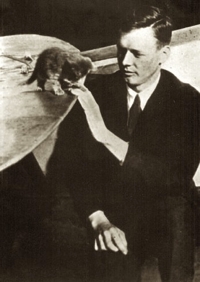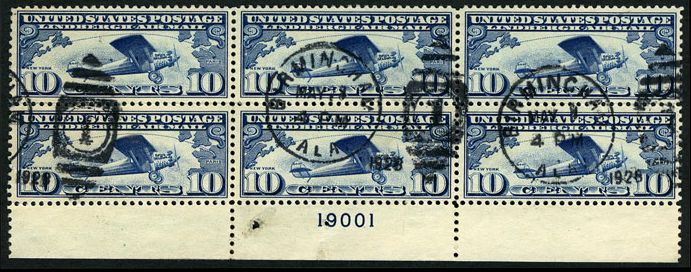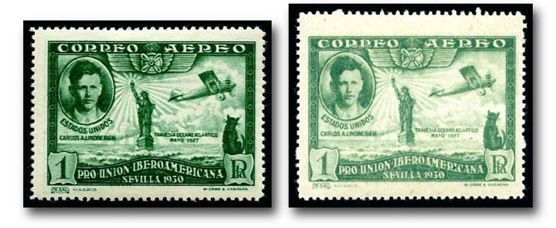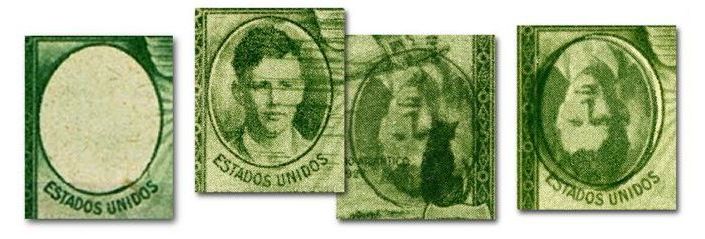A Charles Lindbergh Puzzle ~ What's that darned cat doing there? (Page 2)
On the previous page, I asked why a Spanish airmail stamp issued in 1930 showed a cat watching Charles Lindbergh’s plane, The Spirit of St. Louis. Here’s the answer:
Too dangerous a flight for a kitten named Patsy

Charles Lindbergh had a kitten, named Patsy, who is said to have accompanied on test flights of his new Ryan monoplane, the Spirit of St. Louis. After his New York - Paris flight, he was asked why he didn’t take Patsy with him to Paris. His answer: “It's too dangerous a journey to risk the cat's life.”
Lindbergh was right, of course. Less than two weeks before his 33½ hour flight, the French aviators Charles Nungesser and François Coli attempted to cross the Atlantic from Paris to the USA in a Levasseur PL-8 biplane, L'Oiseau Blanc — The White Bird — but disappeared.
Four other well-known aviators had already lost their lives in pursuit of the Orteig Prize when Lindbergh and the Spirit of St. Louis took off from Roosevelt Field in New York City on his successful attempt in the early morning of Friday, May 20, 1927.

Burdened by a heavy load of gasoline and hampered by a muddy, rain-soaked runway, “The Spirit” slowly gained speed as it made its 7:52 a.m. takeoff run, barely clearing telephone lines at the far end of the field. Over the next 33½ hours, Lindbergh and the Spirit of St. Louis skimmed over storm clouds at 3,000 metres, and over ocean wave tops at an altitude of only three metres. They fought icing, they flew blind through fog for several hours, and they navigated only by the stars (whenever they were visible) and by dead reckoning before landing at Le Bourget Airport in Paris at 10:22 p.m., Saturday, May 21.


Now, about that cat…

Lindbergh actually did take a cat of sorts with him. It was a doll — a good luck, charm, certainly — based on the popular cartoon character, Felix the Cat.
The Spanish Lindbergh stamp, and others of the same set, were printed privately and used as postage for only three days. The owners of the printing plates apparently went on to create poor-quality reprints for the the stamp packet trade.
A mind-boggling array of “varities”
The reprints include a mind-boggling array of “varieties,” all of which seem to have been created intentionally rather than accidentally or as a result of changes in the design of the stamp or in printing methods. The use of two printing plates (one for the vignette of Lindbergh, and one for the remainder of the design) facilitated the creation of stamps that are so unlike the original stamps that they would never have passed inspection for use on mail.1
The reprinted stamps all have blurred impressions and were printed on yellowish paper. They are worth about 10% of the original issues, and include these striking varieties:
• Missing Lindbergh vignette
• Inverted Lindbergh vignette
• Lindbergh vignette printed twice
• Lindbergh vignette poorly centred in oval

The illustration below compares the original bright-green stamp with various dull-green examples of reprints exhibiting some of those varieties:

The following image shows the vignettes of the reprint varieties in detail:

There is no question that Charles Lindbergh made some egregious errors in creating his public image. The fact that he actively promoted Adolph Hitler as an effective leader and publicly declared his belief that the United States should remain isolated in the face of Nazi aggression is unquestioned, but it must be noted that he did eventually accept his responsibility in actively opposing the Third Reich, flying on dozens of U.S. Air Force combat missions against Japanese forces as a civilian contractor in the Pacific Theater of the Second World War.
I personally have great respect for Lindbergh, despite his questionable wartime activities. And I’m not alone. For the philatelic exhibition Cornplex 77, in Bloomington, Illinois, philatelist Tom Geiger, a member of the on-line stamp club StampoRama, created this event cover:

-
The fact that two printing plates were used, one for the vignette of Lindbergh and the other for the remainder of the design, begs this question: Was the original stamp intended to be bi-coloured? There doesn’t seem to be any other reason to use two printing plates rather than just one, which is normal for monochrome stamps. ↩︎